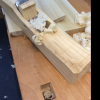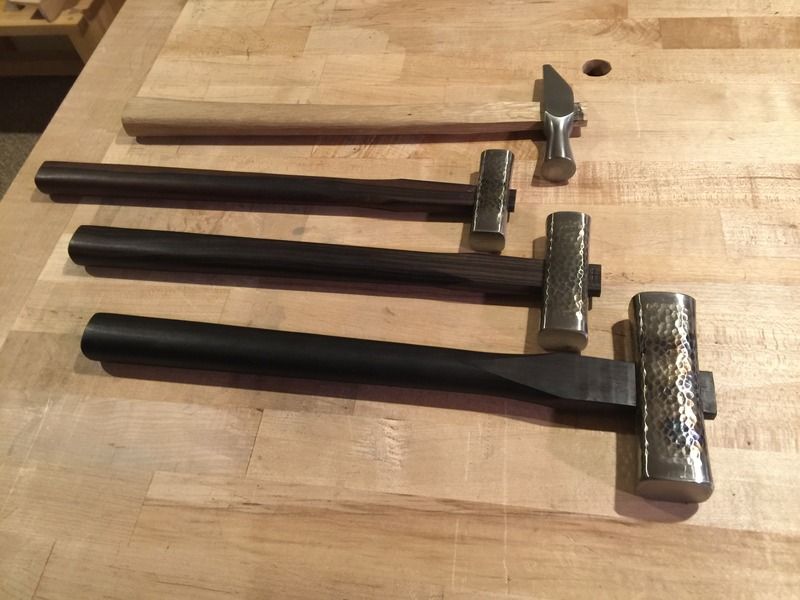There have been several posts lately that have involved hammers in general and Japanese gennou in particular, so I thought it might be helpful to those who do not have much experience with gennou, or that find using a hammer tiring or painful, to post some pics of a couple of my hammers and make some suggestions you might find useful.
First, some definitions. The generic term for hammers in Japanese is kanazuchi 金槌。A gennou 玄翁, on the other hand, is specific type of 2-faced (not a politician) hammer used primarily for woodworking with a flat face on one side and a slightly rounded face on the other. The flat face is intended for striking chisels, planes, and driving nails. The round face is for kigoroshi (bruising wood fibers) and setting nails (last stroke after driving). There are different varieties of gennou, but the ones shown here are the most common type in the Tokyo area. Both heads are shaped slightly differently, with the lighter one being older and of an antique design, but I like it.
Both heads were made by Kosaburo 幸三郎 (長谷川幸三郎), a Tokyo blacksmith who passed away 20 years or so ago. He is said to be the best gennou blackmsith ever.
I made the handles out of black persimmon, a very dense fruitwood highly prized in Japan.
I designed the handles to fit my hand and arm, with the length based on a portion of the length of my forearm. All my gennou handles are the same length from centerline of hammer face to handle's butt (with some minor variations to compensate for handle thickness). As in golf, the swing is the swing, so I do not choke up on my handles. Because of this, I always know exactly where my hammer head will strike without thinking, adjusting my grip, or even having to glance at the hammer. It is an extension of my fingers.
KosaburoKakiLgSide.jpgKosaburoKakiLgsidegoban.jpgKosaburoKakiLgfront.jpgKosaburoKakiMedSide.jpgKosaburoKakiMedSide2.jpgKosaburoKakiMdmBack.jpgGripBack.jpgGripClosedSide.jpg
Notice that the handles are curved, rotating the flat face used for striking chisels down towards the handle's butt. The first photo shows the gennou oriented as if striking a chisel with the flat face facing downwards. The second photo shows the same gennou with the flat face on the right. This is intentional. The amount of this curve depends on the length of the head, so that the curve on the bigger gennou's handle is greater than that of the smaller gennou. This design orients the centerline of the hammer head in very close alignment with the centerline of the chisel handle at the instant of impact, ensuring maximum transfer of energy, minimizing induced vibration in both chisel handle and hammer handle, improving control, and aiding a quick return to battery. Of course, the head's face will be perpendicular to the chisel handle's end at the same instant.
The angled head is the purpose of this design detail, not the curve, which simply facilitates a smooth transition. Some men choose to make the change in angle abrupt, and to my eye, clunky, but that is personal preference. The degree the head must be angled to achieve the ideal alignment between head and chisel handle in use varies from individual to individual. It took years and multiple iterations to develop these dimensions and angles to match my body, the way I work, and my various gennou heads.
When making a gennou handle, be sure to avoid excessive grain runout in the skinny neck area. The greater the curve, the more critical this becomes.
The heads are not secured to the handles with wedge or pins, but are a friction fit in the rectangular eye, which is not tapered in any direction. Some people like to have the wood projecting out of the eye on top. I was taught to either cut it off flush, or better yet, leave the handle slightly recessed inside the eye. As the handle gradually loosens during years of stress, it can easily be driven further into the eye to tighten it up, and will eventually project from the eye. But a recessed handle makes for a neater, more professional appearance IMO, especially when the handle is new. But this is just personal preference.
The first hammer head weights 560 grams (app 20oz). This one is suited for driving heavy chisels such as tataki nomi for structural carpentry and timber framing work. It is too heavy for the more common but lighter-duty oire chisels. I bought it in 1986 (I think).
The second hammer head weighs 375gm (app 13oz). This is a tad on the light side of standard carpenter's gennou, but a tad heavier than what I normally use for joinery and carcase work. I made this handle using the same design parameters as my other gennou, but with different dimensions because of its shorter head and much narrower and shorter eye. The distance from the head's face's centerline to the end of the hammer is approximately the same as the previous heavier gennou because the "swing is the swing."
Allow me to point out several other key points. First, in each case, notice that the handle's sides exiting the eye are straight, with no shoulders. This detail eliminates useless wood, improves balance, reduces air resistance, and greatly reduces vibration reaching the hand. To armchair critics: Give it try before you cry BS or risk being trollish.
Second, notice how the front and side surfaces flair out towards the butt end This detail makes it very easy to hold the hammer securely with only a light fencer's grip while maintaining a flexible wrist, resulting in greater precision and speed with less effort.
Third, notice how the back surface at the grip area is nearly flat, not rounded. I like a wide, flat area here to spread the reaction impact across the heel of my hand where the bone is located just above wrist and below my pinkie finger. A rounded shape here will cause the handle to bruise the bone making my hand sore. This detail is key to using the hammer hard all day without tiring.
Fourth, the front surface near the butt is rounded to make it easy to wrap my fingers around without causing blisters.
Fifth, notice how the two sides of the handle where my thumb and index finger pinch the handle are flat with tightly radiused edges, and are parallel to each other. This detail not only improves my grip, but makes it possible to sense the orientation of the hammer's head at all times and without having to look at the hammer.
Although it is not apparent from the photos, I am not gripping the handle in my fist, but diagonally across the palm touching most strongly at two locations. The first location is the bone located at my palm's heel, just above my wrist and in line with my pinkie. The second location is the space between the first and second joints of my my index finger. This grip was taught to me by my father, who was a carpenter, when I was a boy. It is very common among men around the globe who use hammers constantly. I call this the "Ben Hogan" grip because it resembles the golf club grip that excellent athlete taught.
Fitting the handle to the head in this way makes using the tool instinctive, more efficient, and less tiring. I can pick up the handle and tell the front face of the head from the back, and immediately know the precise angle of the face simply by touch and without looking at the gennou. By comparison, standard one-size-fits-all oval cross-section handles are tiring, inefficient, and clumsy in my experience.
I did not think up these design details. They were developed by specialist carpenters over a period of several hundred years. I adapted them to my body, my gennou heads, and the way I work.
I hope this will clear up some confusion, and gives you a small amount of food for thought in making your own tools more efficient and ergonomic.
Stan




 Reply With Quote
Reply With Quote










